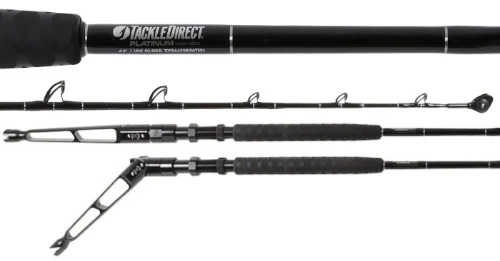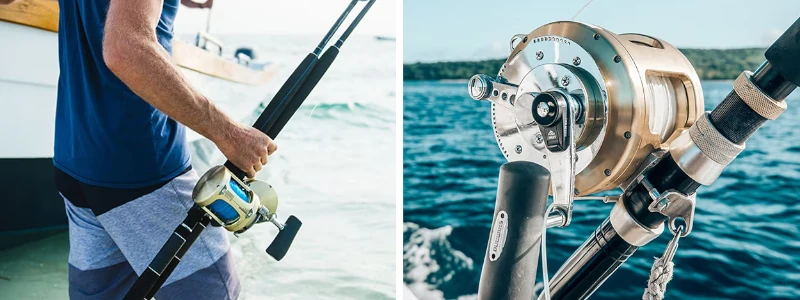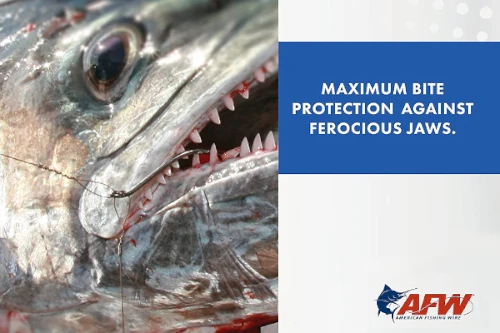Wahoo Trolling Tactics & Tackle
Posted by TackleDirect on Aug 24th 2023

Discover expert-approved wahoo trolling tactics & tackle for a successful fishing adventure. Learn from TackleDirect's seasoned anglers and land your trophy wahoo.
Wahoo Trolling Tactics & Tackle
Wahoo are one of the most sought-after game fish in the world, and for good reason. These fast-moving, powerful fish can reach speeds of up to 60 mph, and they put up a great fight when hooked. Plus, they are delicious! If you're looking to catch a wahoo, trolling is one of the best methods.
Where do you start?
We have you covered with the ultimate wahoo trolling tactics and tackle guide, straight from the vault of TackleDirect's seasoned experts.
The Wonder of Wahoo
Before we dive into the tactics and tackle, let's get to know our star player – the wahoo. Aptly nicknamed "the 'hoo," this oceanic speedster is a prized catch among offshore fishermen. With its sleek body, razor-sharp teeth, and explosive speed, the wahoo presents a thrilling challenge for anglers seeking an adrenaline-pumping battle.
These predators roam warm waters, favoring areas with temperature breaks, current edges, and underwater structures. Wahoo are often found near floating debris, weed lines, and even around larger fish like tuna and mahi-mahi. Now that we've set the stage, let's gear up for the chase!

Wahoo image provided by user: bunker_bill13
Mastering Wahoo Trolling Tactics
Mastering the tactics that draw you closer to these oceanic speedsters is the key to a triumphant angling experience. Follow these tips to get yourself closer to catching the elusive wahoo.
Location & Time
When trolling for wahoo, it is important to fish in the right areas. Wahoo are typically found in warm, tropical waters, and they often follow baitfish schools. They can also be found near reefs, wrecks, and other structures. The best time to troll for wahoo is during the day, when they are more active. Also, keep an eye on your fishfinder to see if there are any baitfish schools in the area. If you are able to time your trip along with a full or new moon while keeping an eye on tides for the day, you will up your chances of ending the day with some wahoo steaks on the grille.
Speed Matters
Wahoo are built for speed, so you'll need to match their pace. High-speed trolling is typically done at speeds of 15-20 knots. This is the best technique for targeting wahoo in open water, where they can reach speeds of up to 60 mph. High speed trolling for wahoo allows you to cover a lot of ground in a day, and that extra speed typically is the deciding factor in getting bit.
Slow trolling is typically done at speeds of 6-10 knots. This is a good technique for targeting wahoo in shallower water, such as around reefs, wrecks, and other large structures that may be holding wahoo in the area.
If you have the opportunity to high speed troll on your way out or back in from deeper water you may just find an extra fish or two in your killbox by the time you make it back to the dock.
Depth Control
Maintaining an accurate depth can be a challenge due to the sheer velocity at which you're moving. Employing planers or downriggers becomes essential to keep your lures at the desired depth when trolling at slower speeds. Both downriggers and planers provide an element of depth to your offshore trolling spread since most of your trolled lures will be higher up in the water column.
Don't Throttle Down
When that unmistakable strike comes, resist the urge to immediately throttle back. Let the wahoo take the bait and run to ensure it does not zip past the boat and break off. Continuing your trolling speed also allows you the opportunity for multiple hook ups at once.
Let's Get to Tackling the 'Hoo
Essential Rods
When setting out to conquer wahoo waters, your choice of rod plays a pivotal role. Opt for sturdy trolling rods with enough backbone. These rods provide the leverage needed to subdue the lightning-fast runs and powerful lunges of the wahoo. Look for rods in the 50-100 lb class range.

TackleDirect Platinum Hook Conventional Winthrop Tip Standup Rod
Model:
TDPS645080WTSIN-Terminator
Recommended Wahoo Rods Include:
- TackleDirect Platinum Hook Conventional Winthrop Tip Standup Rod - Model: TDPS645080WTSIN-Terminator
- Blackfin Fin Deep Drop Rod - Model: #174L
- Shimano Terez BW Uni-Butt High Speed Trolling Rods
Must-Have Reels
Equally crucial to your wahoo trolling setup is the reel. High-capacity reels with smooth and powerful drag systems are essential for controlling the blistering runs of these oceanic speed demons. When choosing a reel, consider options that can hold ample braided line, and plenty of drag to turn them towards the boat at speed. Reels in the size range of 50w class are ideal for most wahoo applications, with 30w reels being adequate for non high speed situations, and 80w reels typically used when targeting massive wahoo in the Bahamas.

Shimano Tiagra A Two Speed Lever Drag Reels
Recommended Wahoo Reels Include:
- Shimano Tiagra A Two Speed Lever Drag Reels - Model: TI50WLRSA
- Shimano Tiagra A Two Speed Lever Drag Reels - Model: TI30WLRSA
- Shimano Tiagra A Two Speed Lever Drag Reels - Model: TI80WA
- Avet EX 2-Speed Lever Drag Big Game Reels - Model: EXW 50/2
- Penn International VI Trolling Reels - Model: INT50VISWS 2 Speed
High-Quality Mainline
In the heart of every successful wahoo trolling setup lies the critical connection between you and your quarry – the mainline and topshot if using one. Opt for a high-quality solid or hollow core braided mainline that boasts both strength and a slim diameter for its breaking strength. Braided lines provide minimal stretch and less resistance when trolling at high speeds. For high speeding we recommend hi-vis 100lb braid without a mono topshot. With the ability to withstand the intense forces exerted by a charging wahoo, your line is your direct link to success.

Diamond Braid Generation III Hollow Core Line
Recommended Wahoo Line Include:
- Diamond Braid Generation III Hollow Core Line
- Cortland C16 Hollow Super Braid Fishing Line
- PowerPro Braided Spectra Fiber Fishing Line Hi-Vis Yellow
- Momoi Diamond Monofilament Line
Strong Leaders
While you may get more bites using fluorocarbon leader if rigging your own lures, a single strand or cable leader is typically preferred to reduce the chance of getting cut off by a wahoo's razor sharp teeth. When high speed trolling, you will need to also incorporate a monofilament shock leader for added stretch that braid does not offer, which will help reduce breakoffs and pulled hooks.

American Fishing Wire Tooth Proof Single Strand Leader Wire
Recommended Wahoo Leaders Include:
- American Fishing Wire Tooth Proof Single Strand Leader Wire
- American Fishing Wire - 49-Strand Cable
- Fathom Offshore TW-SL Shock Leader
Enticing Lures
The wahoo's aggressive nature calls for equally enticing lures. High-speed lures, such as jet heads and bullet-shaped plugs, mimic the prey wahoo love to chase while tracking straight at high speeds. Consider using dark colors that will stand out. When slow trolling, skirted ballyhoo and strip baits work wonders. Change your lures out if not getting bites until you find the hot color for the day. Sometimes wahoo can be finicky and they'll only hit a certain type or color of lure.

Black Bart Lures Wahoo Rigged Heavy Tackle Trolling Pack
Recommended Wahoo Lures Include:
- Black Bart Lures Wahoo Rigged Heavy Tackle Trolling Pack
- Black Bart Lures Medium Tackle Lures San Sal Candy
- Yo-Zuri Bonita Lures
- Nomad Design DTX Minnow
- Nomad Design Madmacs
- Iland Ilander Heavy-Weight Lures
- C&H Billy Baits Mister Big Lures
- C&H Wahoo Whacker XL Lure
- L. B. Huntington Drone Spoons
Time for Your 'Hoo Hunt
And there you have it, folks – a quick guide to wahoo trolling tactics and tackle, straight from TackleDirect's experienced anglers. Armed with the right gear and knowledge, you're now ready to chase down these oceanic speed demons and hopefully enjoy some sashimi after your next trip out. So, gather your crew, hit the waters, and let the adventure unfold – the 'hoo awaits!

Wahoo image provided by user: godeepoc

Wahoo image provided by user: rebecca_redington
Main Banner Image:
Provided by User:
lacanafishing
Want a chance at getting your fishing image featured?
Just Tag Your Next Catch With #HookedOnTD.
Head on over to the TackleDirect Social page for more details.

